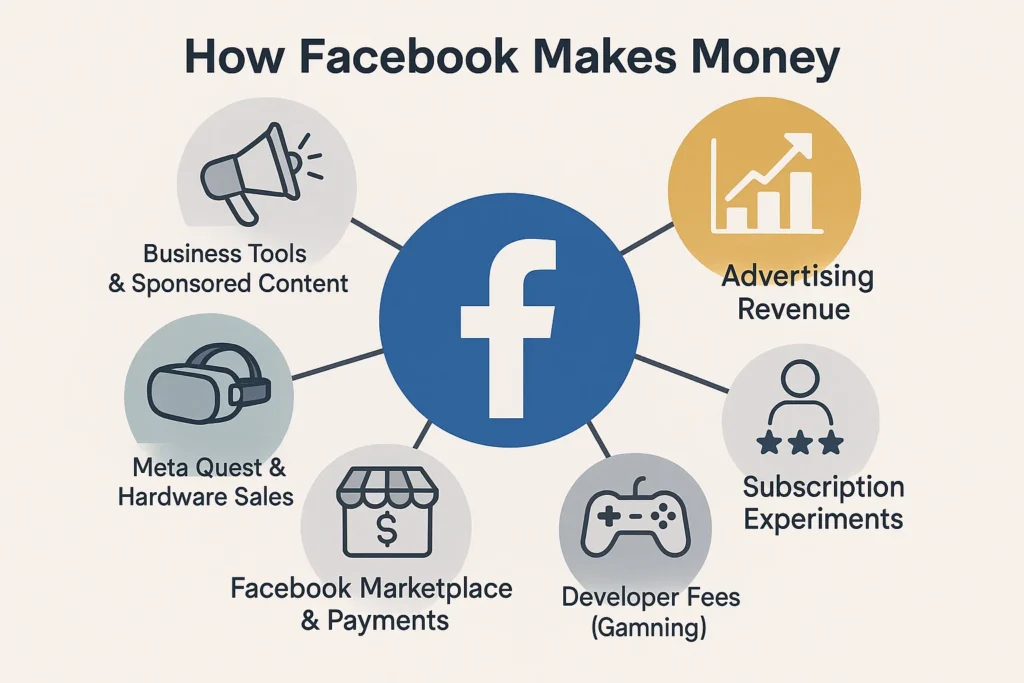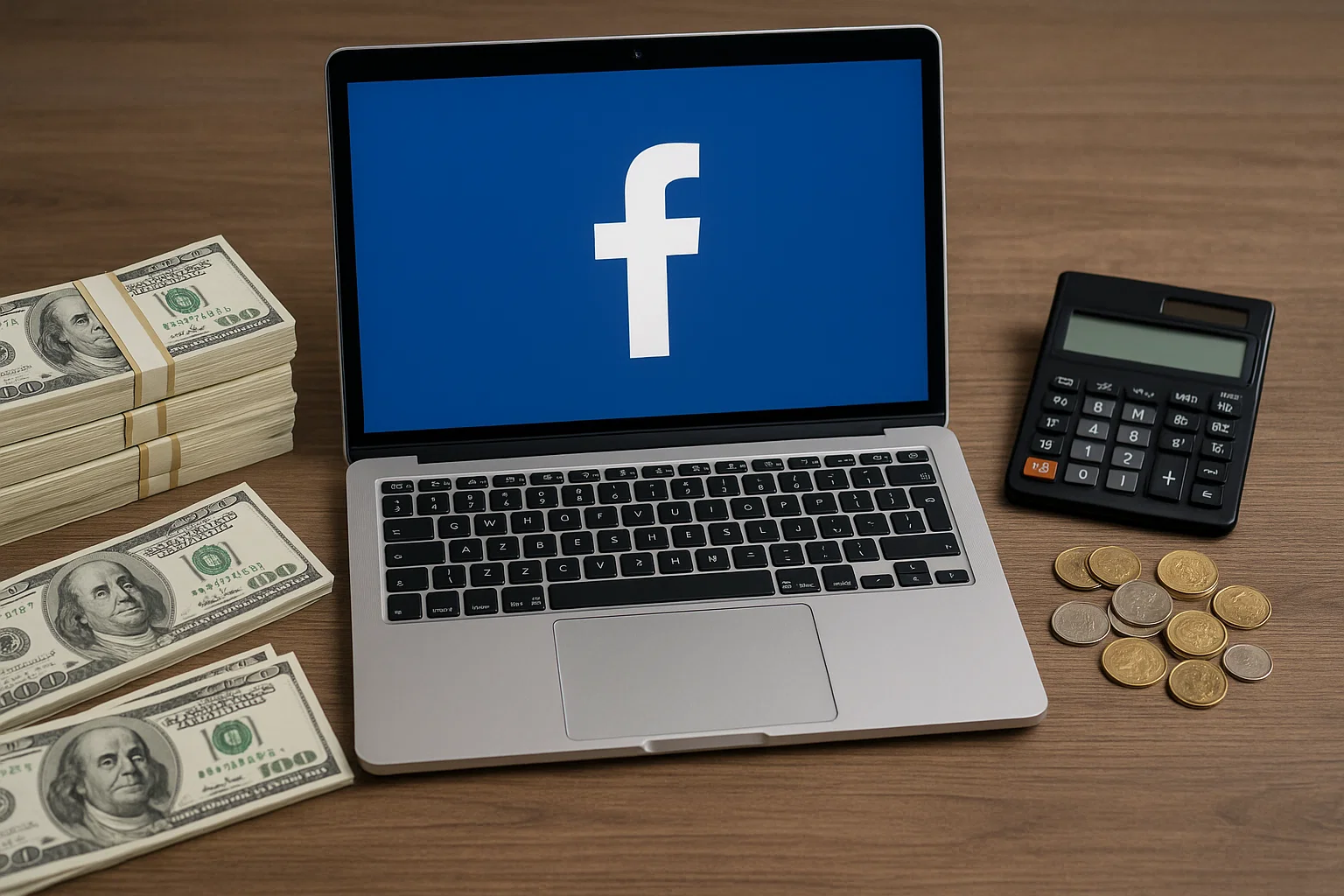Facebook — now operating under its parent brand Meta — isn’t just a social media platform; it’s one of the most profitable digital advertising machines the world has ever seen. What started as a college network in 2004 has grown into a global ecosystem with over 3 billion monthly active users across Facebook, Instagram, Messenger, and WhatsApp.
Despite being free to use, Facebook consistently pulls in tens of billions in annual revenue. The secret? A hyper-targeted advertising engine powered by user data, engagement metrics, and AI algorithms that deliver results for businesses of all sizes.
In this blog, we’ll explore how Facebook earns money, break down its revenue streams, and explain how startups can replicate aspects of this model using a ready-to-launch Facebook clone from Miracuves.
How Facebook Makes Money
Facebook’s revenue is overwhelmingly driven by its advertising business — but there are other key sources of income as well. Here’s a quick breakdown of how Facebook monetizes its vast user base:
- Advertising Revenue – The core driver, contributing over 97% of total revenue.
- Business Tools and Sponsored Content – Boosted posts, branded content tools, and business suite subscriptions.
- Meta Quest & Hardware Sales – Revenue from VR headsets, smart glasses, and accessories.
- Facebook Marketplace & Payments – Limited transaction revenue via commerce, in-app payments, and commissions.
- Developer Fees (Facebook Gaming, Apps) – Commissions from in-app purchases or virtual goods via Facebook’s developer platform.
- Subscription Experiments – Creator monetization via fan subscriptions, Facebook Stars, and in-stream ads.

While advertising is the powerhouse, Meta continues diversifying its revenue streams through hardware, payments, and creator-focused features.
Facebook built the world’s largest social network by turning connections into commerce—explore the Facebook business model to see how it works.
Detailed Breakdown of Revenue Channels
Advertising Revenue
The lifeblood of Facebook’s business model is advertising. Over 97% of its total revenue comes from businesses that pay to run ads across Facebook, Instagram, and Messenger. Facebook’s Ads Manager allows hyper-targeting based on user demographics, interests, behaviors, and real-time activity.
- Who Pays? Small businesses, brands, agencies, and large enterprises.
- Why It Scales? Low barrier to entry, self-serve ad platform, massive global reach.
Business Tools and Sponsored Content
Facebook offers additional monetization tools for businesses and creators. These include boosted posts, branded content tagging, and access to Meta Business Suite for ad management, analytics, and customer messaging.
- Who Pays? SMBs and creators promoting their content or pages.
- Why It Scales? Converts organic users into paying advertisers.
Meta Quest & Hardware Sales
Meta generates revenue from sales of Oculus VR headsets (now branded Meta Quest), Ray-Ban smart glasses, and related accessories. While still a smaller portion of revenue, it reflects Facebook’s long-term bet on the metaverse.
- Who Pays? Consumers and developers interested in VR experiences.
- Why It Scales? Expands Facebook’s ecosystem into immersive tech.
Facebook Marketplace & Payments
Facebook Marketplace allows users to list and browse items locally. While most transactions are free, Facebook has begun monetizing select transactions with commission fees (e.g., shipping-enabled items in the U.S.). Payment infrastructure also powers limited in-app purchases.
- Who Pays? Sellers, buyers, and developers via platform fees.
- Why It Scales? Adds new revenue layers without disrupting user experience.
Developer and Creator Monetization
Developers who offer games and apps on Facebook (especially via Facebook Gaming) share a cut of in-app revenue with the platform. Creators also earn from features like Facebook Stars, in-stream ads, and fan subscriptions — where Facebook takes a commission.
- Who Pays? Fans, users, and developers.
- Why It Scales? Encourages creator economy growth within the platform.
Experimental Subscriptions
Facebook has introduced tools like Meta Verified (a subscription for creators and public figures), as well as test features for ad-free experiences and exclusive content. These features are still evolving but signal Meta’s intent to diversify further.
- Who Pays? Verified users, fans, and premium subscribers.
- Why It Scales? Low-friction upsells for power users and loyal fans.
From News Feed to Messenger, Facebook keeps billions connected—explore the top Facebook features that made it a global phenomenon.
Why This Revenue Model Works in 2025
Facebook’s revenue engine remains remarkably effective in 2025 — and that’s no accident. Its dominance is the result of evolving tech, shifting user behavior, and strategic diversification.
Hyper-Targeted Advertising in a Privacy-Conscious World
Despite tighter privacy regulations (like GDPR and Apple’s ATT), Facebook has adapted with AI-driven contextual targeting and machine learning models that preserve ad performance. Advertisers continue to see ROI, keeping the ad engine strong.
Creator Economy Boom
2025 has seen exponential growth in creator-led businesses. Facebook’s support for monetization tools — such as subscriptions, Stars, and Reels ads — taps directly into this boom, helping creators earn while Facebook takes a platform cut.
Meta Ecosystem Synergy
Facebook’s integration with Instagram, WhatsApp, and Messenger ensures it can monetize across user touchpoints. A user browsing on Instagram may see an ad served by Facebook’s unified platform, boosting cross-app revenue.
Hardware and VR Momentum
With Meta Quest gaining popularity and new smart wearables hitting the market, Facebook’s hardware segment is starting to show revenue promise. This aligns with long-term metaverse ambitions while adding diversity to the income stream.
Low Friction, High Engagement
Facebook remains free to use, ensuring massive daily engagement. That engagement is what powers its monetization — whether via ads, creator tips, business tools, or new premium features.
Facebook turned social connections into a growth engine—explore the Facebook app marketing strategy that keeps it winning worldwide.
Can Startups Replicate Facebook’s Revenue Model?
Yes — but replicating Facebook’s revenue model from scratch isn’t for the faint-hearted. It requires deep technical expertise, a scalable backend, secure data architecture, and a UX that encourages both engagement and monetization.
The complexity of building features like ad engines, creator tools, and in-app purchases is exactly why many founders turn to proven, ready-made solutions.
That’s where Miracuves steps in.
With our powerful Facebook Clone, startups can launch their own social media platform equipped with monetization tools right out of the box. Whether you’re targeting a niche audience, building a creator-first community, or launching a regional social network — our solution gives you the flexibility to monetize from day one.
The Facebook Clone by Miracuves is a fully customizable white-label social networking platform priced at $2,899.00 (originally $3,699.00).
It enables modern social interactions with posts, stories, live streams, and advanced user engagement tools.
Go live in just 3 days with free 1-year updates and Miracuves’ complete setup support.
Here’s what our Facebook clone includes:
- Built-in ad module for self-serve promotions and sponsored content
- Creator monetization options like tips, subscriptions, and post boosts
- Group and community features for scalable user engagement
- Marketplace integration with commission management
- Multi-language support, mobile apps, and real-time chat features
- Admin panel to control monetization settings, user tiers, and analytics
With Miracuves, you don’t just get a codebase — you get a platform designed to generate revenue.
Understanding what the Facebook app is and how it works gives you a clear view of the features that made it a global success—and when you’re ready to build your own, our Facebook-style app development cost guide helps you budget smartly from MVP to scale.
Conclusion
Facebook’s revenue model is a testament to the power of platform-based monetization — driven by ads, business tools, creator ecosystems, and a growing hardware portfolio. Even in 2025, it remains one of the most profitable digital platforms by leveraging user engagement, personalization, and cross-platform integration.
While replicating Facebook’s scale is ambitious, replicating its monetization strategy is entirely possible — especially with the right technology partner.
At Miracuves, we empower startups to build and launch feature-rich social platforms that come ready with monetization levers — from ad management to premium content, tipping systems, and more.
FAQs
How does Facebook generate revenue?
Facebook generates most of its revenue from digital advertising. Businesses pay to display targeted ads to users based on demographics, behavior, and interests. Additional income comes from subscriptions, creator tools, and hardware sales.
Is Facebook profitable in 2025?
Yes, Facebook remains highly profitable in 2025. Its ad business continues to grow, and newer revenue streams like Meta Quest hardware and creator monetization tools contribute to long-term profitability.
What are the main income sources for Facebook?
Primary income sources include advertising, branded content, VR hardware sales (Meta Quest), in-app payments, and commissions from creator monetization tools such as subscriptions and Stars.
Can startups use the same revenue model as Facebook?
Yes, but building a monetization-focused social network from scratch is complex. Startups can replicate Facebook’s revenue model using ready-made clone solutions like the Facebook Clone by Miracuves.
Does Miracuves offer a Facebook clone with monetization features?
Absolutely. Miracuves offers a powerful Facebook clone with ad modules, tipping features, subscription support, business tools, and community management — built to support scalable monetization.








